The Remarkable Ribblehead Viaduct and Its Impact on Railway History
The Ribblehead Viaduct, an iconic symbol of Victorian engineering and perseverance, is the largest and most impressive of the viaducts on the Settle to Carlisle railway line. Its majestic arches stretch across the rugged landscape of Batty Moss in Ribblehead, North Yorkshire, and serve as a testament to the ambitious vision and skill of the engineers and labourers who brought the railway line to life.
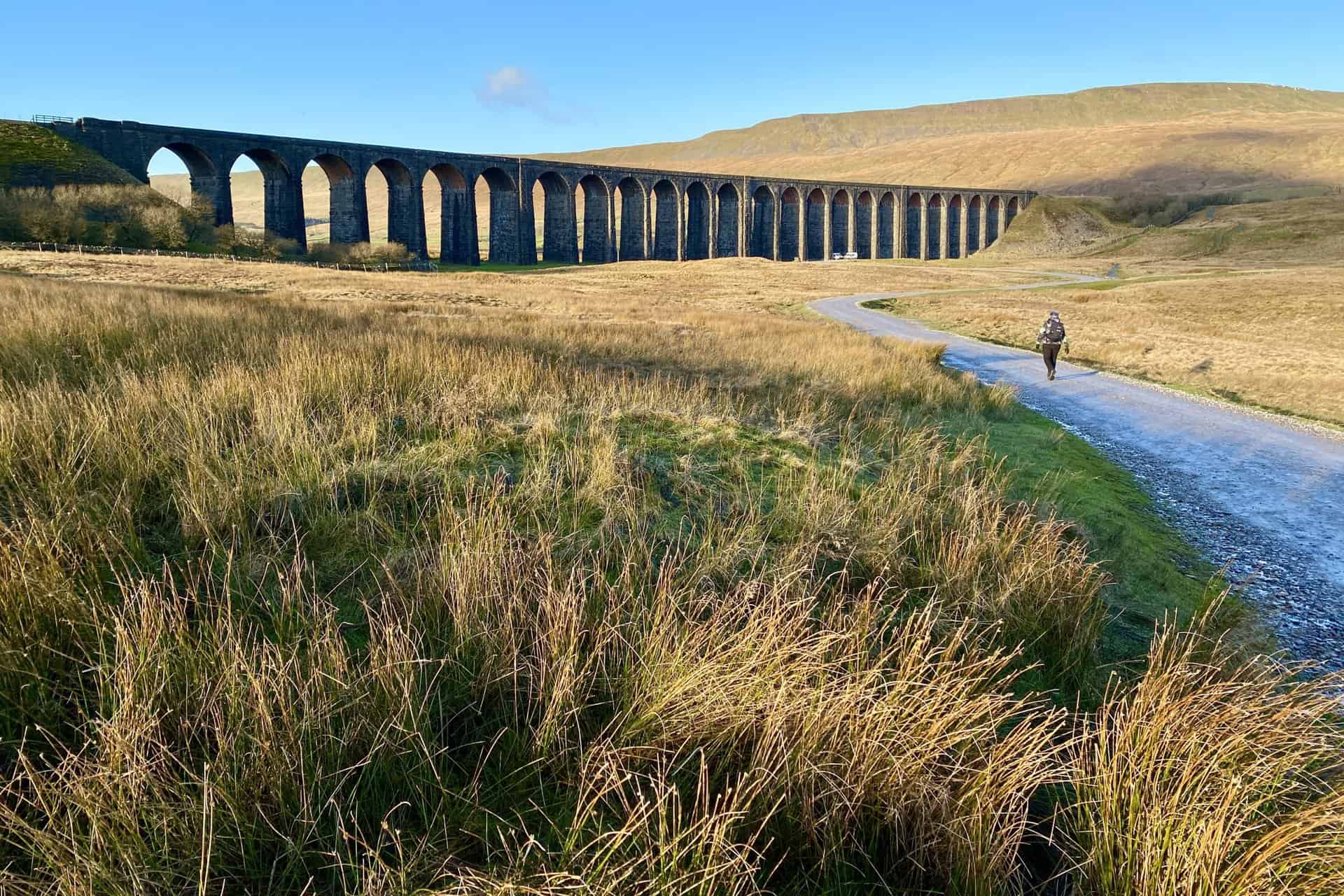
Significance of the Ribblehead Viaduct
The Ribblehead Viaduct holds great historical, architectural, and cultural significance. As an integral part of the Settle to Carlisle line, it has played a crucial role in the growth in the region. The viaduct is an outstanding example of Victorian craftsmanship, showcasing the innovation and determination of its era. Moreover, the structure serves as a poignant reminder of the harsh conditions endured by the workers who constructed it, many of whom lost their lives in the process.
Overview of the Settle to Carlisle Railway Line
The 72-mile-long Settle to Carlisle railway line was constructed in the 1870s by the Midland Railway company. Driven by the ambition to capitalise on the burgeoning rail traffic between England and Scotland, the company embarked on a project to build a line through the challenging terrain of North Yorkshire and Cumbria. This undertaking necessitated the construction of numerous substantial structures, including tunnels, bridges, and viaducts.
The railway line was designed to connect the Midland line between Skipton and Carnforth to the city of Carlisle, passing through several picturesque and remote landscapes along the way. The Settle to Carlisle line, now a vital part of the region’s transportation network, still carries passenger and freight traffic today. Additionally, the line has become a popular tourist attraction, offering visitors the opportunity to experience the breathtaking scenery of the Yorkshire Dales while travelling on a historic route.
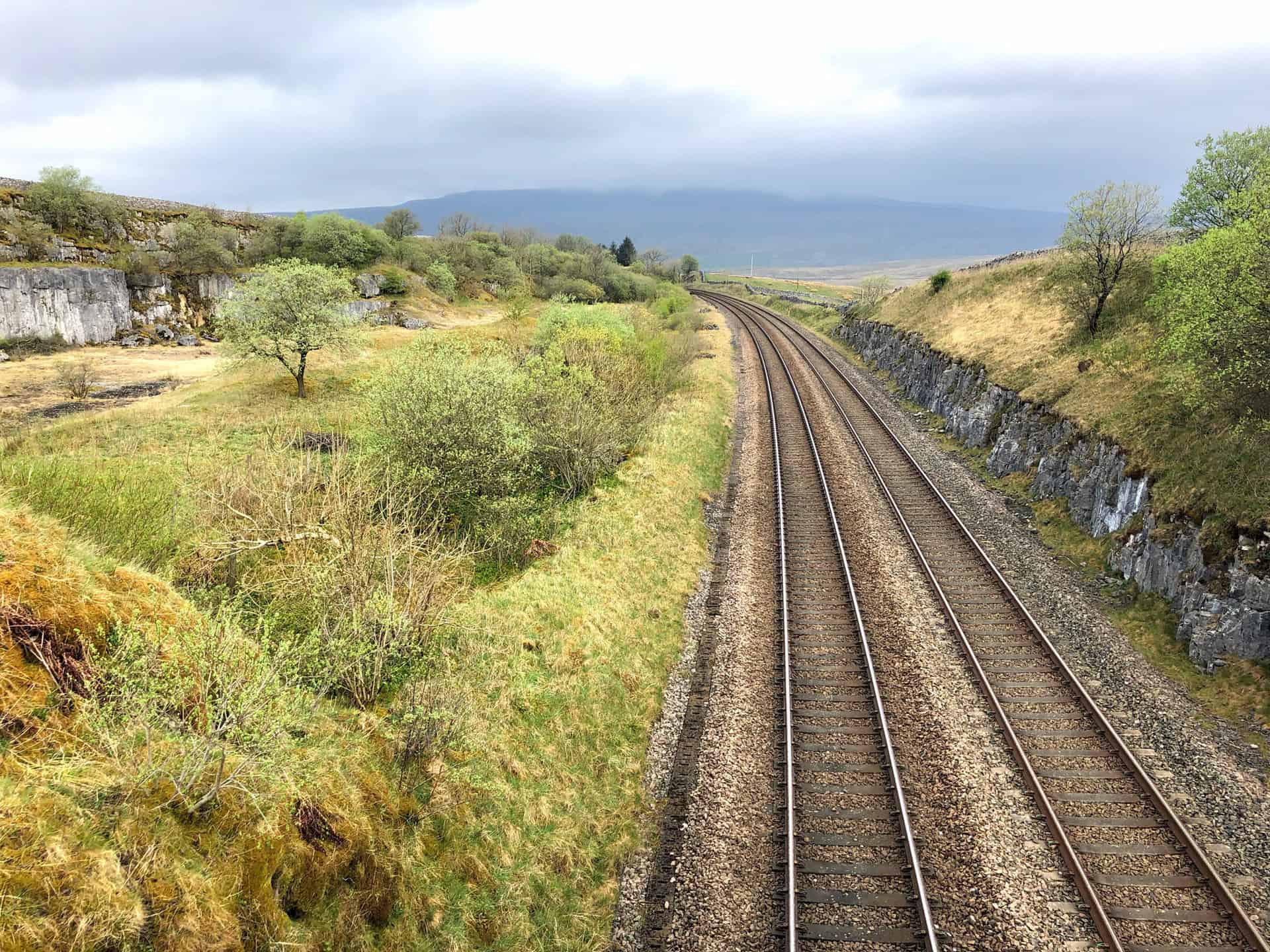
Location and Accessibility
Nestled in the heart of the Yorkshire Dales National Park, the viaduct’s accessibility and stunning surroundings make it a popular destination for tourists, railway enthusiasts, and walkers alike.
Geographical Location and Grid Reference
Located within the Craven District Authority and the Parish of Ingleton, the Ribblehead Viaduct, also known as Batty Moss Viaduct, carries the Settle to Carlisle line across Batty Moss at Ribblehead. Situated at the head of the Ribblesdale valley, the viaduct lies beneath the south-eastern slopes of Whernside, one of the peaks in the Yorkshire Three Peaks Challenge. The Ordnance Survey grid reference for the Ribblehead Viaduct is SD 75944 79471.
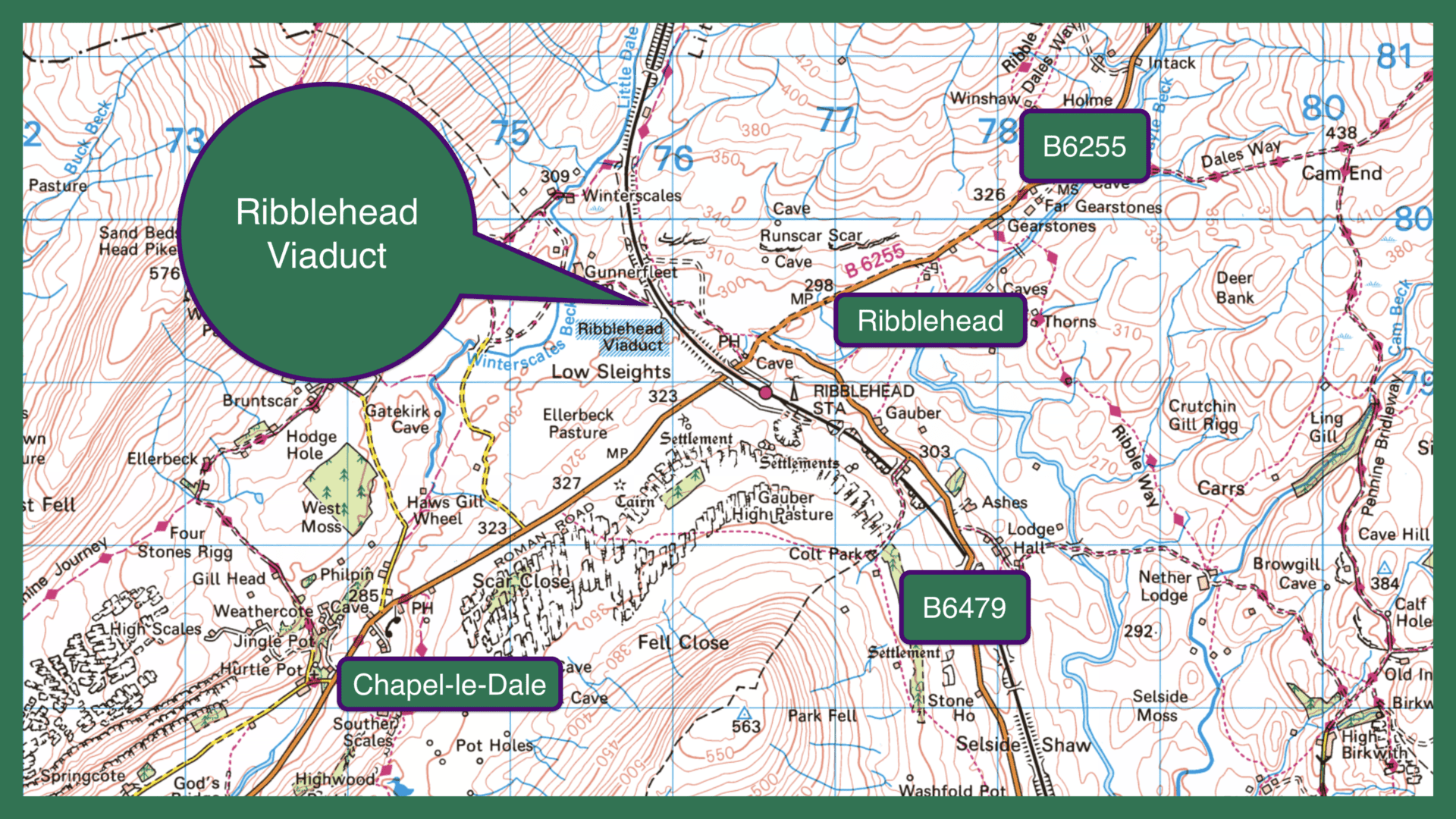
Nearby Towns and Roads
The viaduct is positioned by the side of the B6255 Hawes to Ingleton road, close to the junction with the B6479 Horton in Ribblesdale road. Its location 6 miles north-east of Ingleton and 10 miles south-west of Hawes provides visitors with options for accommodation and local amenities.
Ribblehead Viaduct Parking and Visitor Information
Visitors to the Ribblehead Viaduct can make use of the ample roadside parking available nearby, although during peak times and weekends, spaces can fill up quickly.
Importance for Walkers of the Yorkshire Three Peaks Challenge
As a key landmark on the popular Yorkshire Three Peaks Challenge, the Ribblehead Viaduct holds special significance for walkers. The challenge, which connects the mountains of Pen-y-ghent, Whernside, and Ingleborough, covers a distance of 24 miles and is renowned for its demanding terrain and stunning vistas.
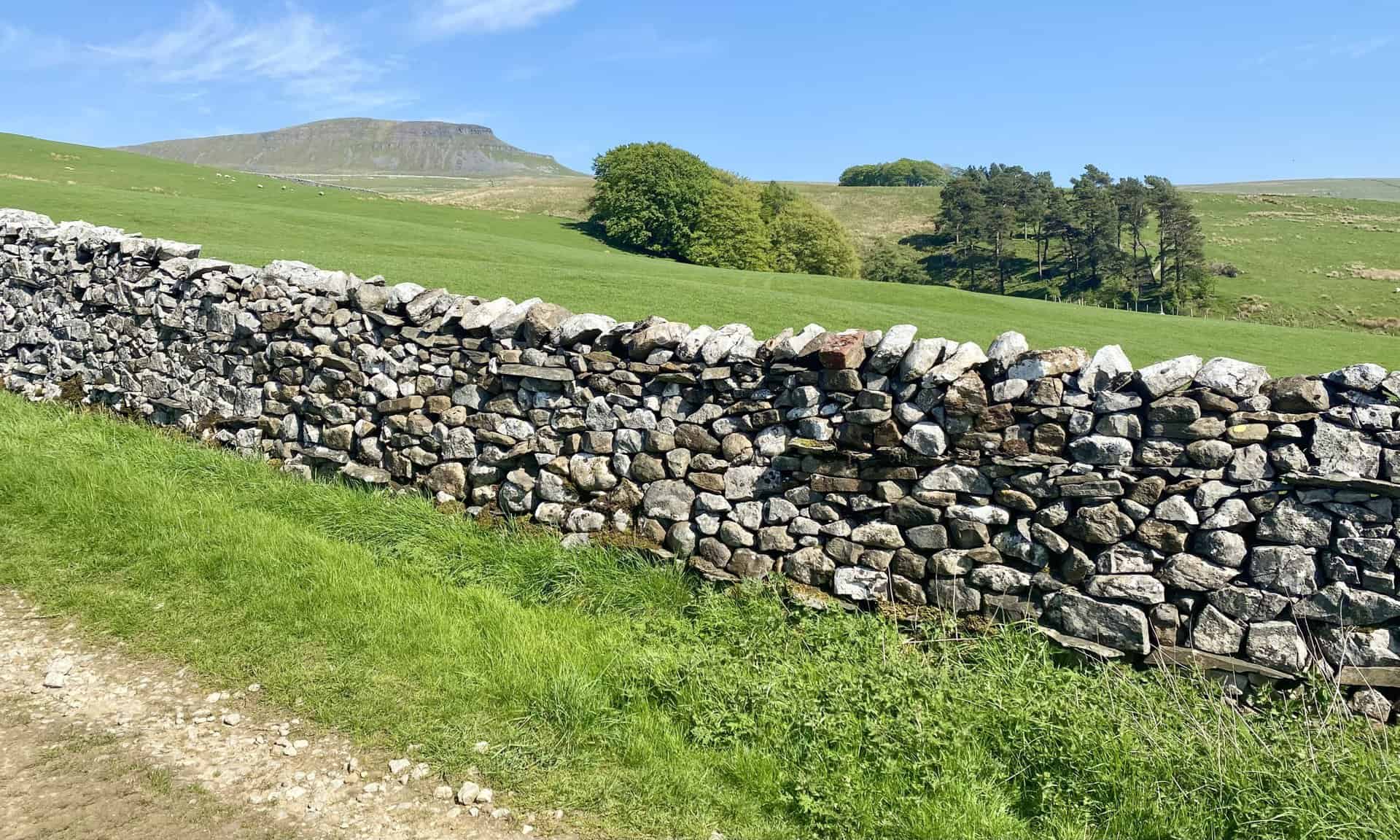
Historical Background
The Ribblehead Viaduct’s imposing presence in the Yorkshire Dales is a symbol of the ambitious plans of the Midland Railway during the Victorian era. The viaduct’s construction stemmed from the company’s desire to gain advantage from the lucrative England to Scotland rail traffic.
Midland Railway’s Ambition to Capitalise on England to Scotland Rail Traffic
In the 1860s, the Midland Railway aimed to establish a new line connecting Settle and Carlisle that would link the Midland line between Skipton and Carnforth to the city of Carlisle.
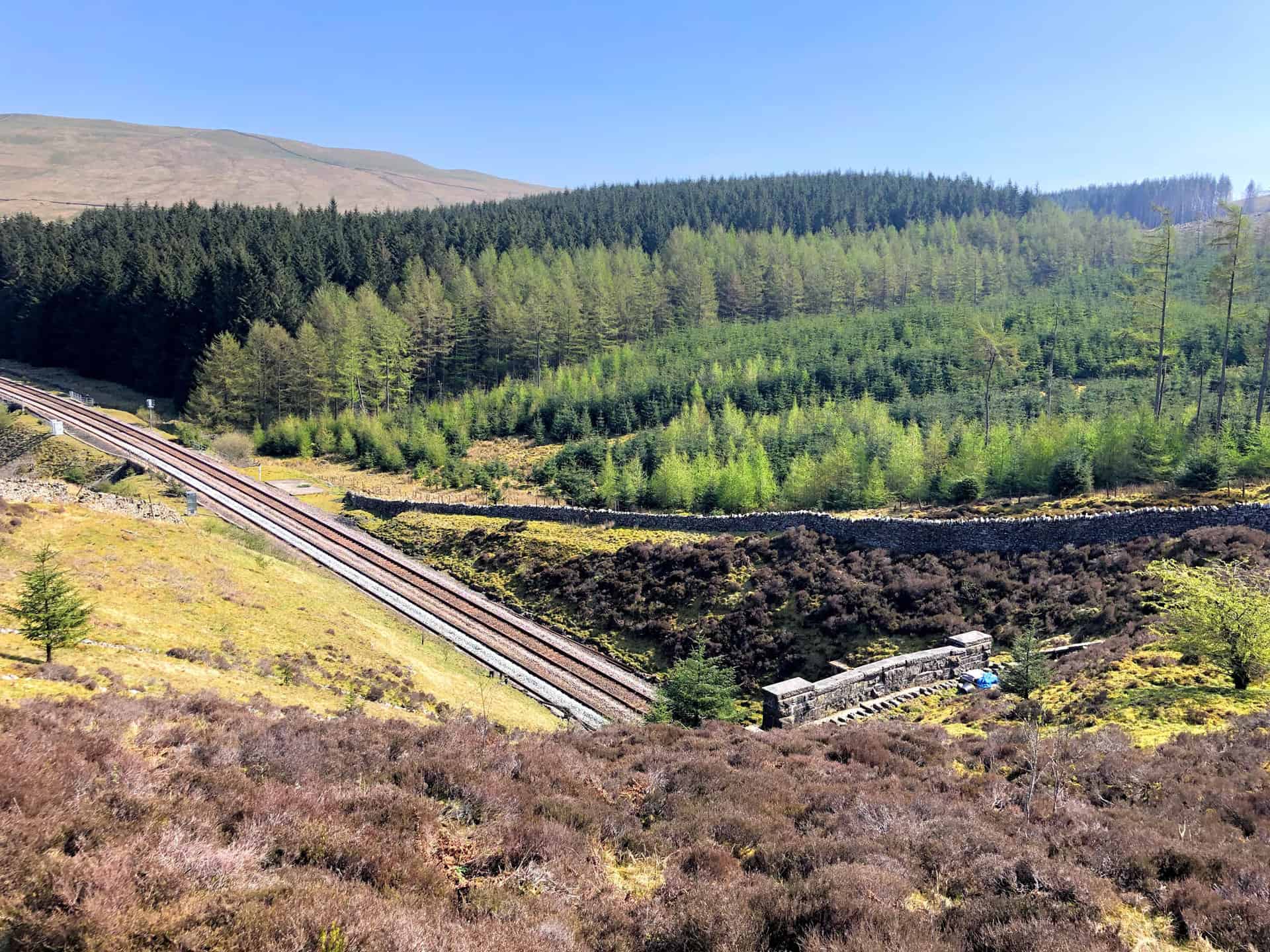
The Passing of the Midland Railway (Settle To Carlisle) Act and Subsequent Developments
On 16 July 1866, the Midland Railway (Settle to Carlisle) Act was passed by Parliament, granting the company the authority to construct railways from Settle to Hawes, Appleby, and Carlisle, among other locations. However, after the Act’s passing, the Midland Railway reached an agreement with the London & North Western Railway to run services on the LNWR line via Shap. This led the company to apply for a bill of abandonment for its original plan. Parliament rejected the bill on 16 April 1869, compelling the Midland Railway to proceed with the construction of the Settle to Carlisle line.
The Role of John Sydney Crossley and James Joseph Allport
John Sydney Crossley, the company’s chief engineer, and James Joseph Allport, its general manager, played pivotal roles in the development of the Settle to Carlisle line. The men conducted surveys of the challenging terrain that the line would traverse. Crossley was responsible for designing and overseeing the construction of all the major works on the line, including the Ribblehead Viaduct.
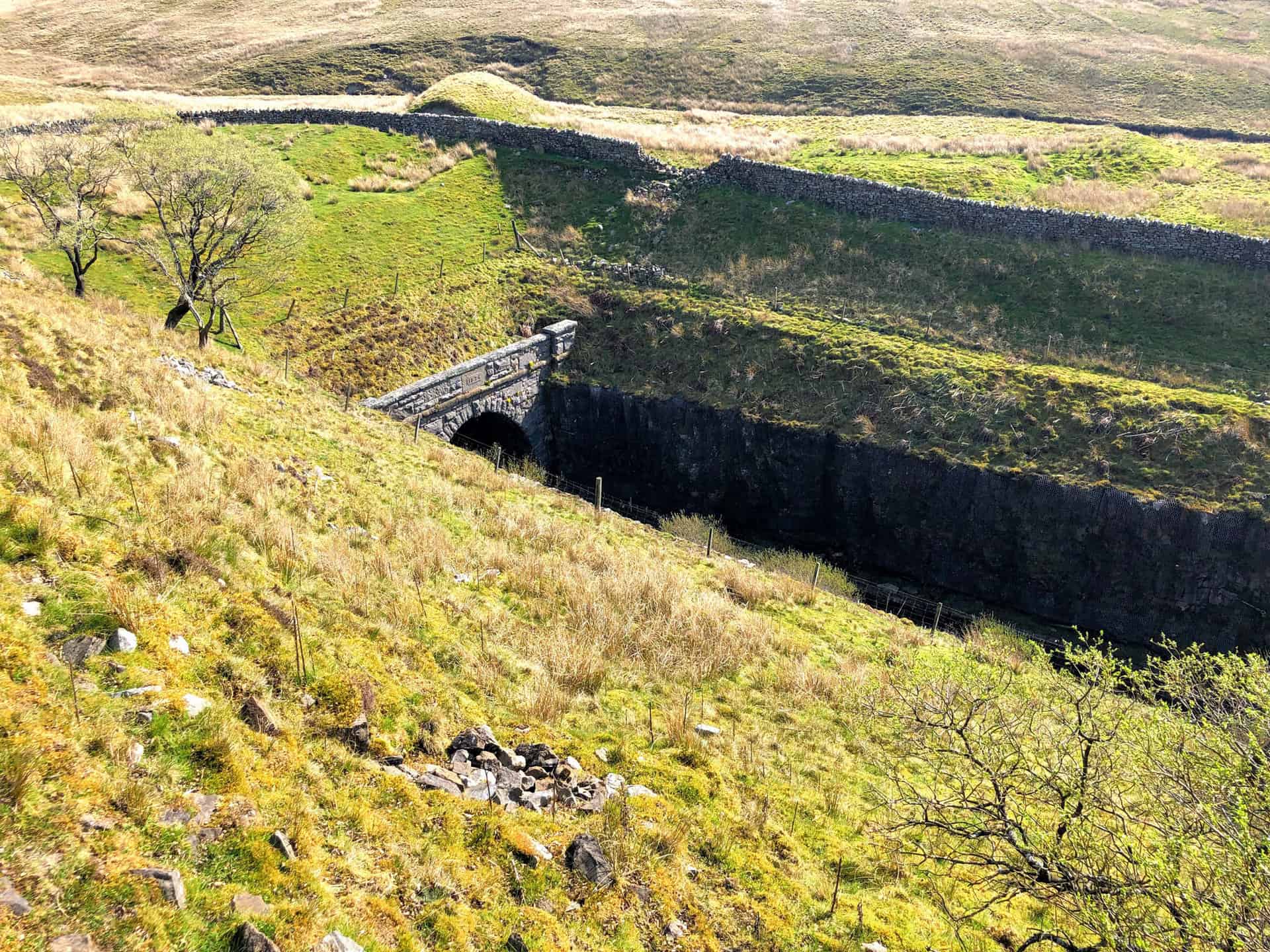
Awarding and Cancellation of John Ashwell’s Contract
On 6 November 1869, a contract to construct the Settle Junction to Dent Head Viaduct section, including the Ribblehead Viaduct, was awarded to contractor John Ashwell. However, financial difficulties plagued Ashwell, and by mutual agreement, his contract was cancelled on 26 October 1871. From this point onwards, the viaduct’s construction was managed by the Midland Railway, working on a semi-contractual basis under the supervision of William Ashwell.
Construction Camps and Worker Conditions
The Ribblehead Viaduct’s construction relied on a workforce of up to 2300 men. These workers, often accompanied by their families, lived in temporary camps located on land adjacent to the viaduct. These camps, also known as navvy settlements, were self-supporting communities established during the Industrial Revolution to facilitate major engineering projects, such as railways, bridges, canals, and reservoirs. The quality of accommodation and facilities at these camps varied considerably, with some workers subjected to exploitation through the truck system, whereby they were paid in tokens that could only be exchanged at company shops at inflated prices. Tragically, more than a hundred workers lost their lives during the construction process due to accidents, fighting, or outbreaks of smallpox.
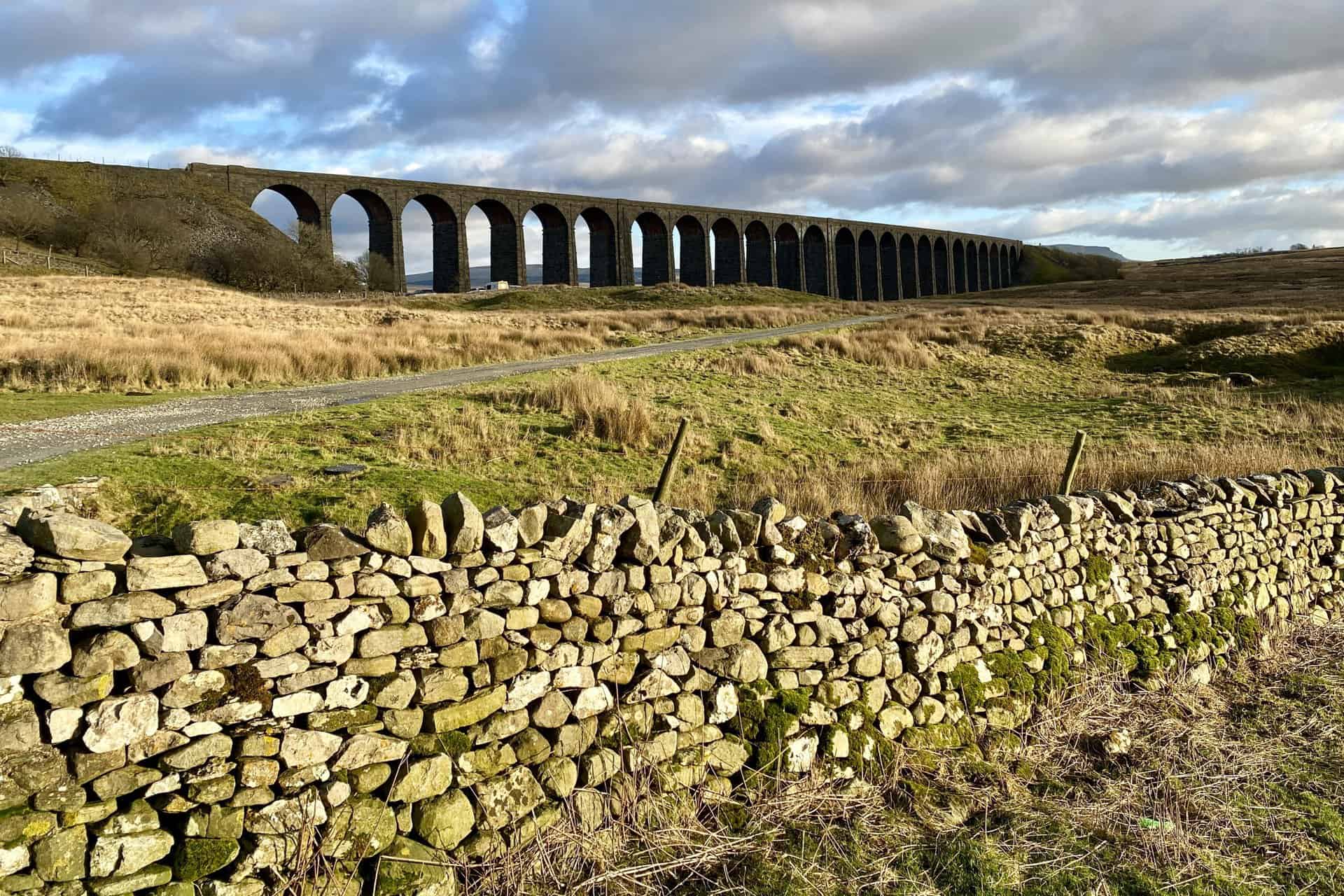
Construction of the Ribblehead Viaduct
The construction of the Ribblehead Viaduct, an engineering marvel of the Victorian era, represents a significant chapter in the history of Britain’s railway infrastructure.
Timeline of the Construction Process
The construction of the Ribblehead Viaduct commenced in July 1870 with the start of work on the foundations. On 12 October 1870, contractor’s agent William Henry Ashwell laid the first stone. Following the cancellation of John Ashwell’s contract on 26 October 1871, the Midland Railway took over the construction.
By August 1874, the arches had been keyed, and the last stone was laid by the end of the year. A single track was laid over the viaduct, and on 6 September 1874, the first train carrying passengers were hauled across by the locomotive Diamond. Finally, on 3 August 1875, the viaduct was opened for freight traffic, and on 1 May 1876, the whole line opened for passenger services, following approval by Colonel F. H. Rich from the Board of Trade.

Accidents, Illnesses, and Fatalities
The construction of the Ribblehead Viaduct was a dangerous endeavour, with more than a hundred workers losing their lives due to construction-related accidents, fighting, or outbreaks of smallpox. Church of England records show that there are around 200 burials of men, women, and children in the graveyard at Chapel-le-Dale.
Memorial at Chapel-le-Dale
In remembrance of the workers who lost their lives during the construction of the Ribblehead Viaduct, a memorial has been erected in the graveyard at Chapel-le-Dale.
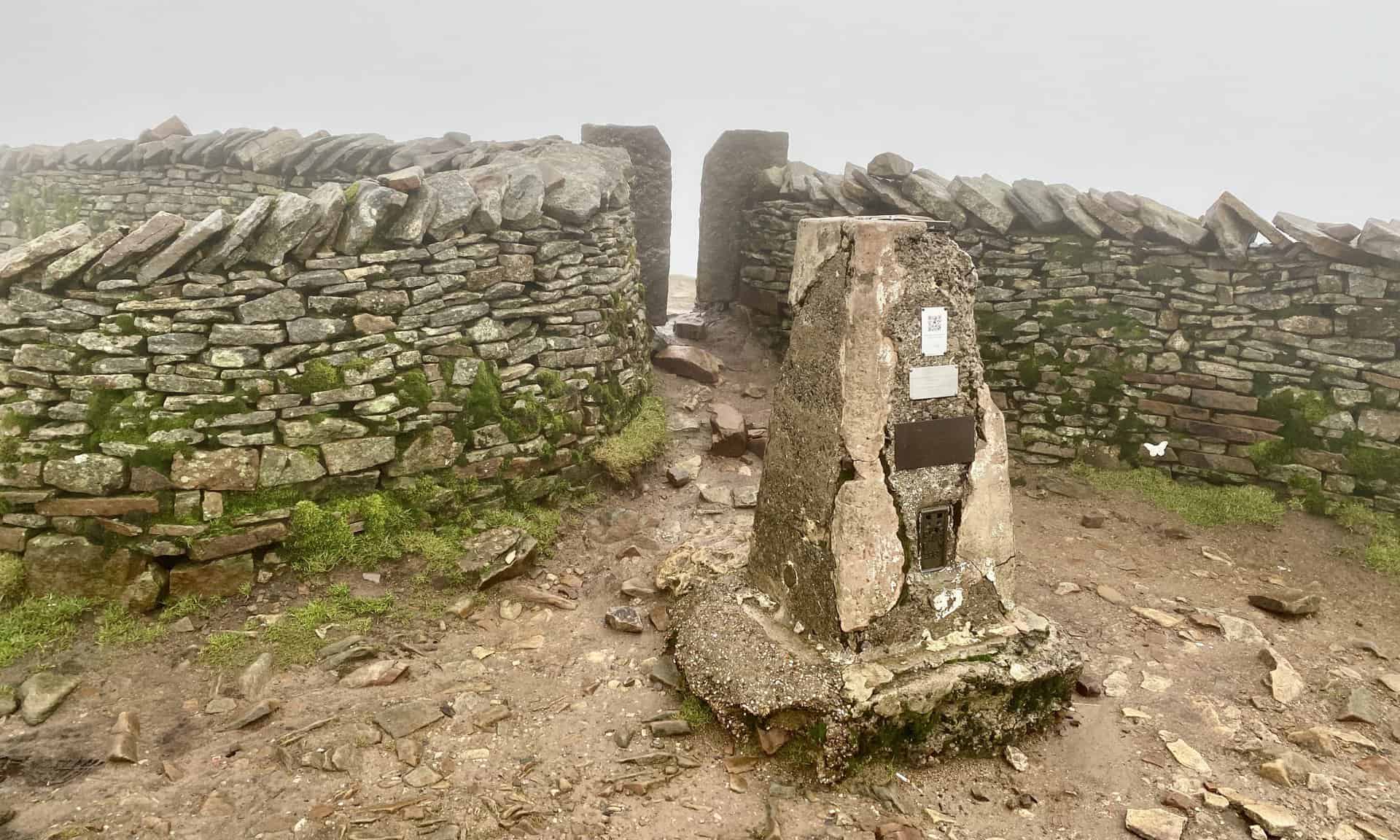
Ribblehead Viaduct Design and Specifications
The Ribblehead Viaduct represents the pinnacle of Victorian engineering. Its remarkable design, specifications, dimensions and materials used during its construction have made the Ribblehead Viaduct a lasting testament to human ingenuity and perseverance.
Dimensions and Materials Used
The Ribblehead Viaduct is an impressive structure that spans over 400 metres in length and stands 32 metres above the valley floor at its highest point. Its robust design incorporates 24 arches, each with a span of 13.7 metres, and foundations reaching a depth of 7.6 metres. The viaduct was designed to accommodate a pair of tracks aligned over the sleeper walls.
Various materials were used in the construction of the Ribblehead Viaduct. The structure is faced with limestone masonry set in hydraulic lime mortar, while the near-semicircular arches are made of red brick, constructed in five separate rings, with stone voussoirs. The sleeper walls rise from the arches to support the stone slabs of the viaduct’s deck, and hollow spandrels support plain solid parapet walls. In total, 1.5 million bricks were used, and some of the limestone blocks weigh as much as eight tons.
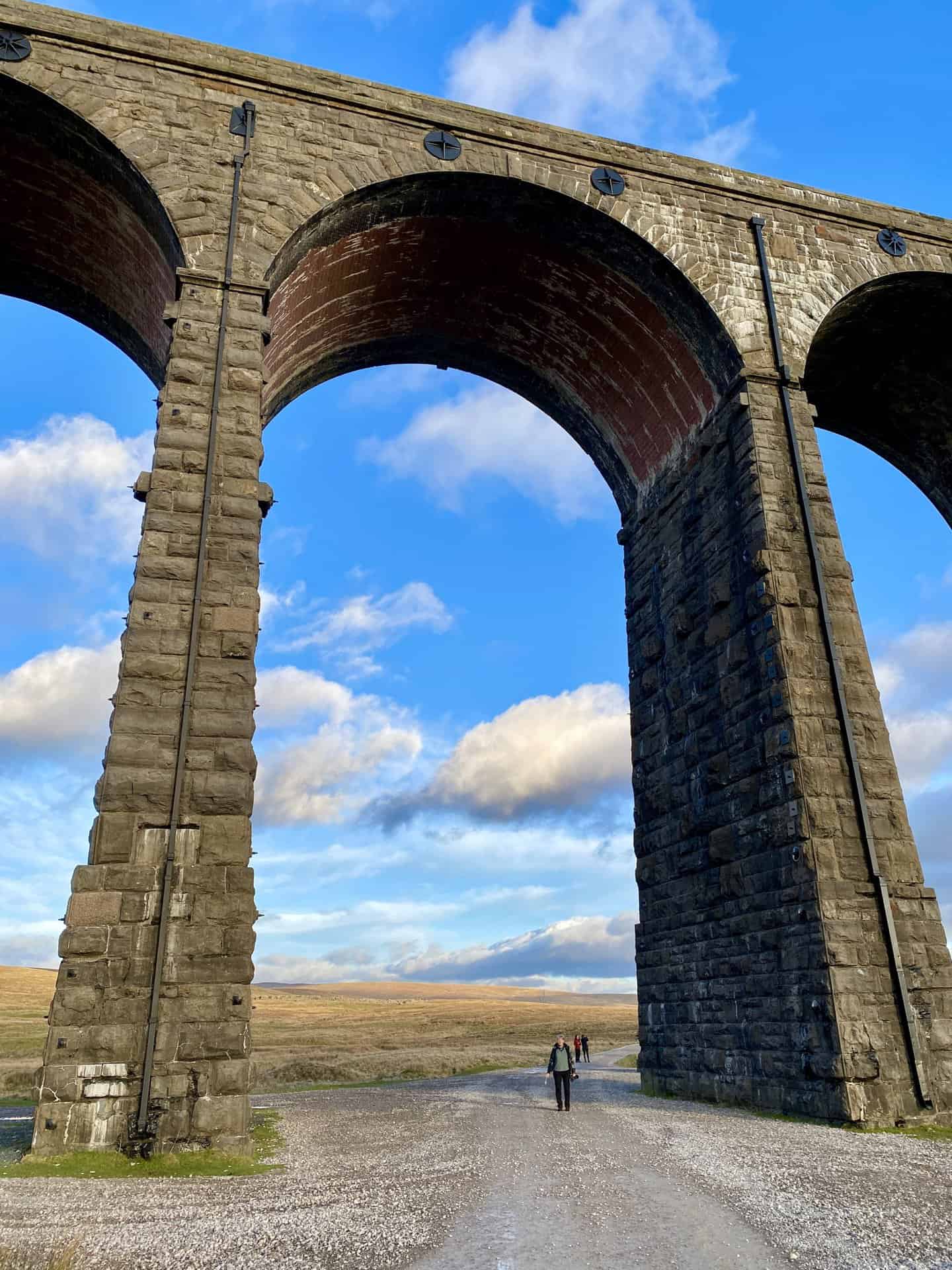
Unique Features and Engineering Techniques
One of the distinguishing characteristics of the Ribblehead Viaduct is its tapered piers, which measure approximately 4 metres across at the base and 1.8 metres thick near the arches. The piers are filled with loosely-packed rubble cores. Every sixth pier is 50% thicker to mitigate against collapse should any of the piers fail. The northern end of the viaduct is 4 metres higher in elevation than the south, resulting in a gradient of 1:100.
The viaduct is 300 metres above sea level and exposed to the prevailing westerly wind. The structure’s height, from foundation to rails, is 50.3 metres. It is 404.8 metres long on a lateral curve with a radius of 0.85 miles, making it the longest structure on the Settle to Carlisle railway line.
The Settle to Carlisle railway line has two taller viaducts, Smardale Viaduct at 40 metres near Crosby Garrett, and Arten Gill at 36 metres.
The Settle to Carlisle line was the last main railway in Britain to be constructed primarily with manual labour.
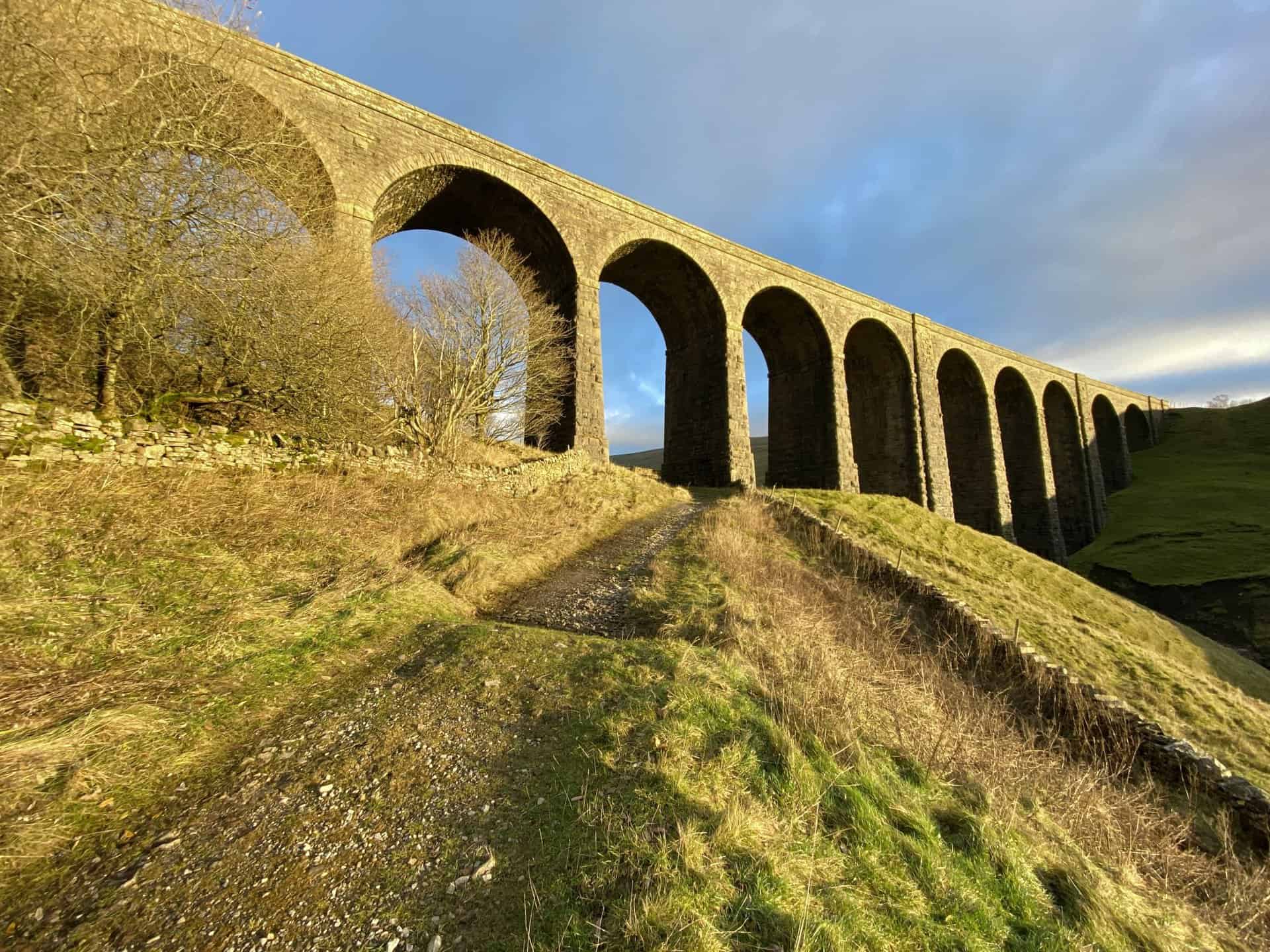
Challenges and Repairs
The Ribblehead Viaduct has faced numerous challenges and undergone many repairs throughout its history.
Weather-Related Incidents
The Ribblehead Viaduct is situated 300 metres above sea level on exposed moorland, making it vulnerable to the prevailing westerly winds. Its susceptibility to severe weather conditions has led to a few notable incidents. In 1964, for example, several Humber cars were blown off their wagons while being transported over the viaduct on a freight train.
Repairs in the 1980s and 1990s
By 1980, the Ribblehead Viaduct had fallen into disrepair, with many of its piers weakened by water ingress. Between 1981 and 1984, repairs were carried out at a cost of approximately £100,000. These repairs included strengthening the piers with steel rails and concrete cladding. In 1988, minor repairs were executed, and trial bores were made into several piers. Between 1990 and 1992, the viaduct underwent a significant restoration, further ensuring its structural stability and longevity.
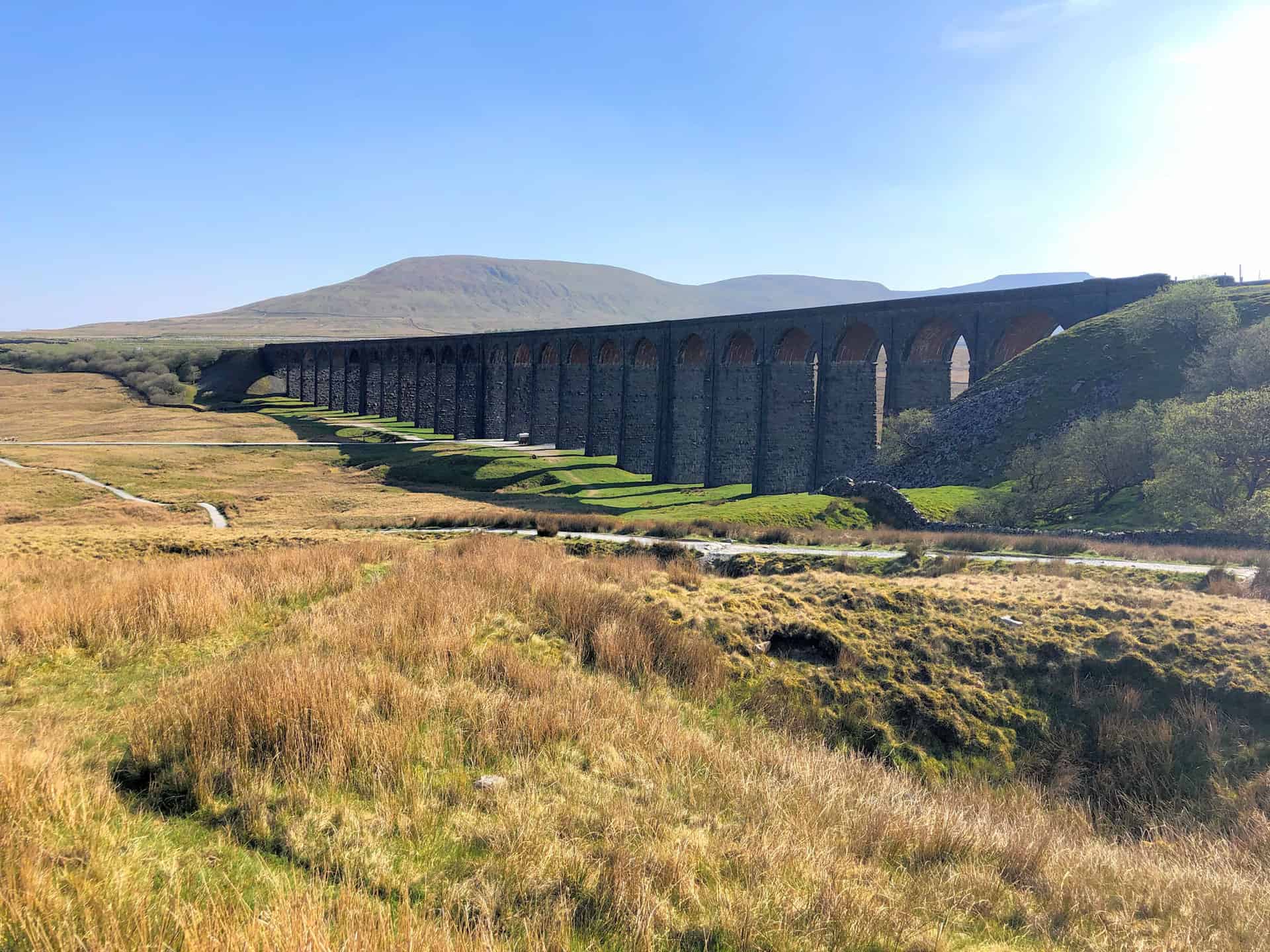
Reduced Track Usage and Speed Limits
For safety reasons, the line was reduced to a single track across the viaduct to avoid the simultaneous loading from two trains crossing. Additionally, a 20mph speed limit was imposed, which helped alleviate the stress on the structure and minimise the risk of accidents.
Waterproofing and Further Assessments
In 1989, a waterproof membrane was installed to protect the viaduct from water ingress and subsequent damage. This proactive approach to preservation has been essential in maintaining the structure’s stability. In addition to waterproofing, the viaduct has undergone further assessments, such as the trial bores conducted in 1988. Major restoration work commenced in November 2020 as part of a £2.1 million project to re-point mortar joints and replace broken stones. Network Rail released a time-lapse video of the works in June 2021, showcasing the ongoing efforts to preserve the structure.
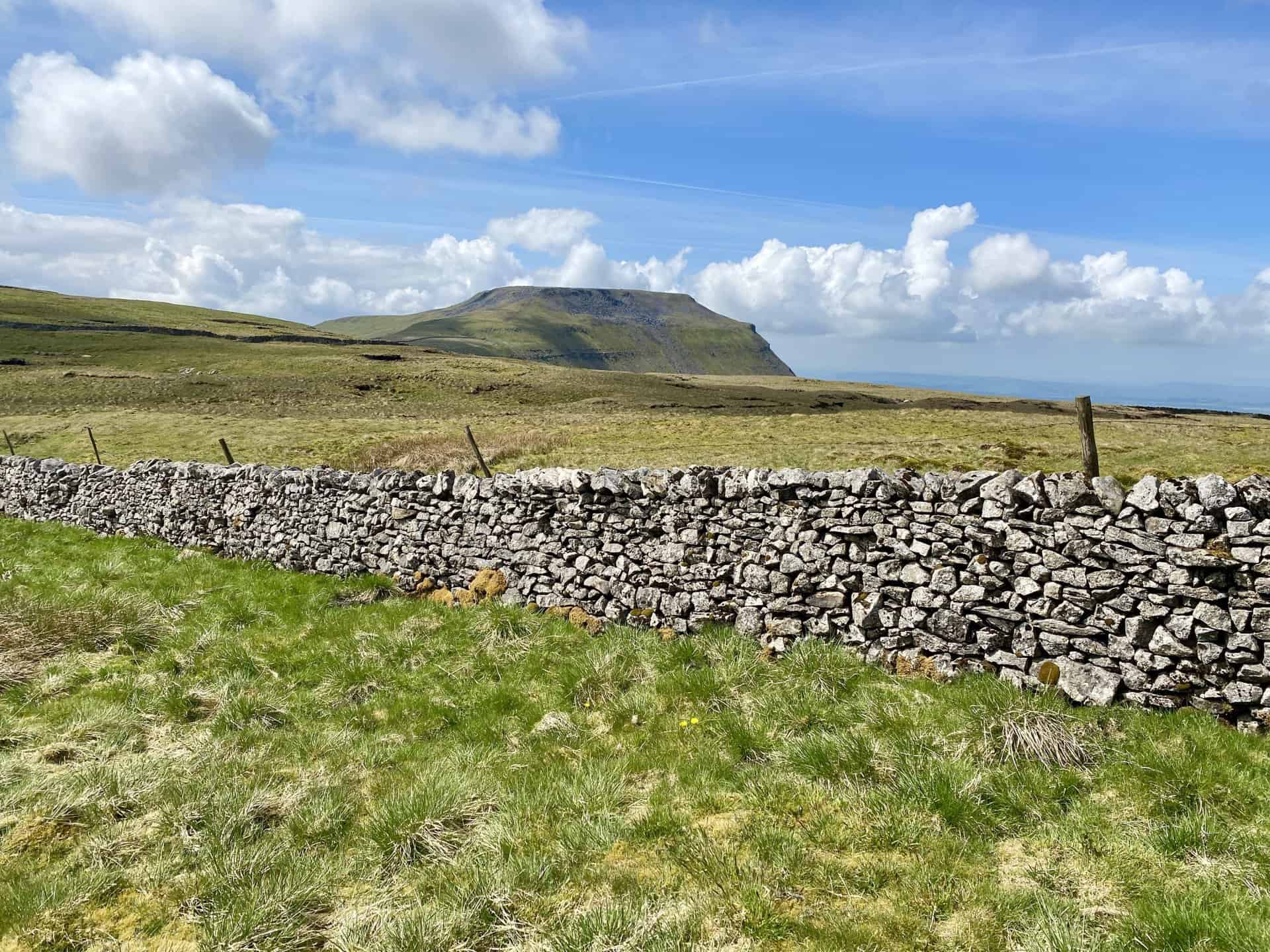
Campaign to Save the Settle to Carlisle Railway Line
The Ribblehead Viaduct is an integral part of the Settle to Carlisle railway line, which faced the threat of closure in the 1980s due to the high cost of repairs. However, the line’s future was secured by the relentless efforts of dedicated campaigners and a reevaluation of the economic and engineering factors involved.
Friends of the Settle-Carlisle Line (FoSCL)
In the 1980s, British Rail proposed closing the Settle to Carlisle line due to the high cost of repairing its major structures, including the Ribblehead Viaduct. Recognising the cultural, historical, and economic significance of the line, a group of passionate individuals formed the Friends of the Settle-Carlisle Line (FoSCL) in 1981. This organisation played a crucial role in garnering and mobilising public support against the closure plan.
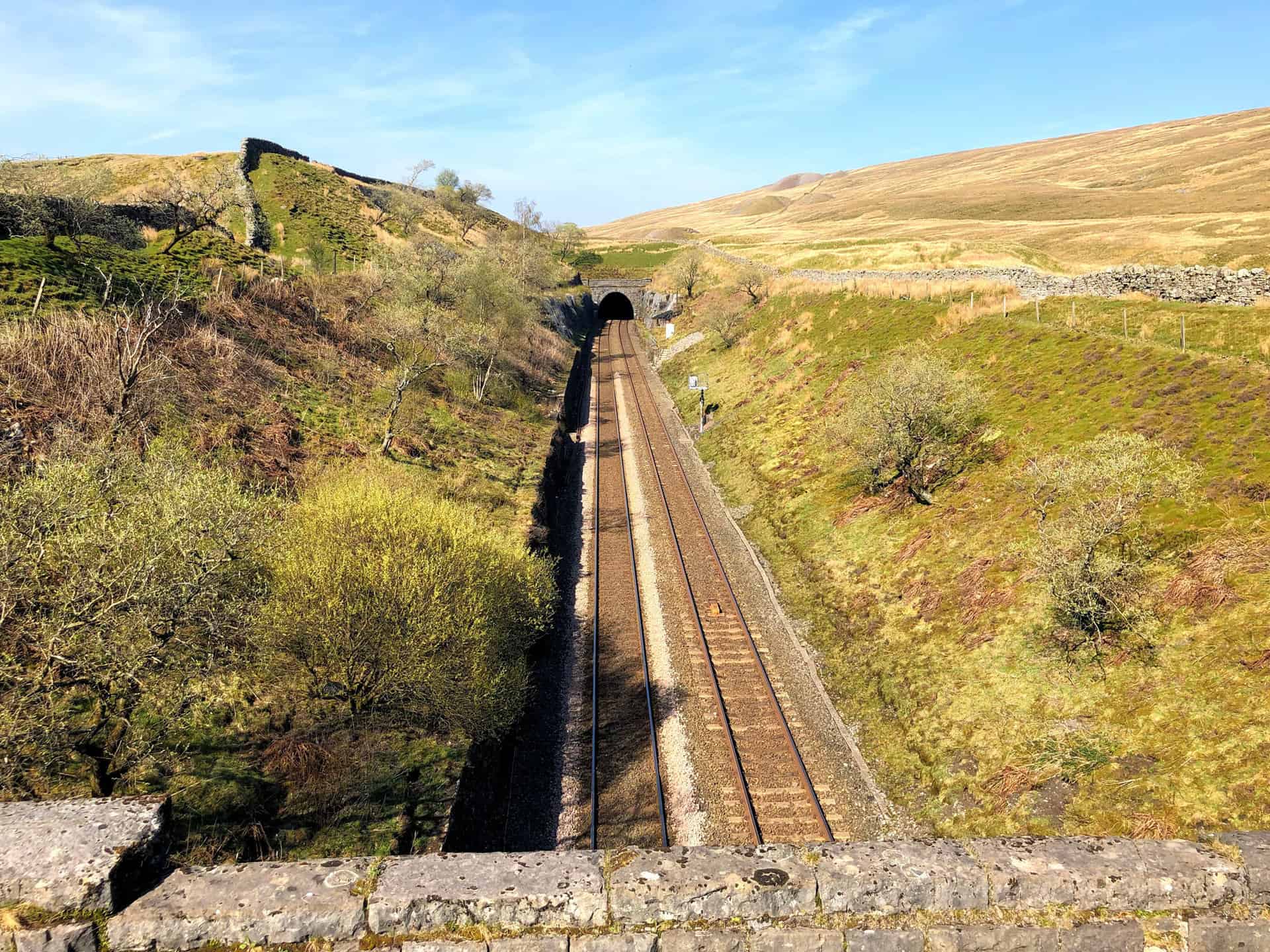
Factors Leading to the Preservation of the Line
Several factors contributed to the preservation of the Settle to Carlisle railway line, ultimately saving it from closure. One key factor was the weakening of the economic arguments for closing the line. Michael Portillo, who took the decision to keep the line open, noted that a spike in passenger numbers during the 1980s had undermined the rationale for closure.
Another crucial factor was the reassessment of the cost of restoration work. Further studies by engineers determined that the repairs required for the line’s major structures, including Ribblehead Viaduct, would not be as costly as initially estimated. This development made the prospect of preserving the line financially more viable.
Finally, the unwavering dedication and tireless efforts of the Friends of the Settle-Carlisle Line played a pivotal role in changing public opinion and attracting political support for the preservation of the line. In 1989, the Settle to Carlisle railway line was saved from closure.
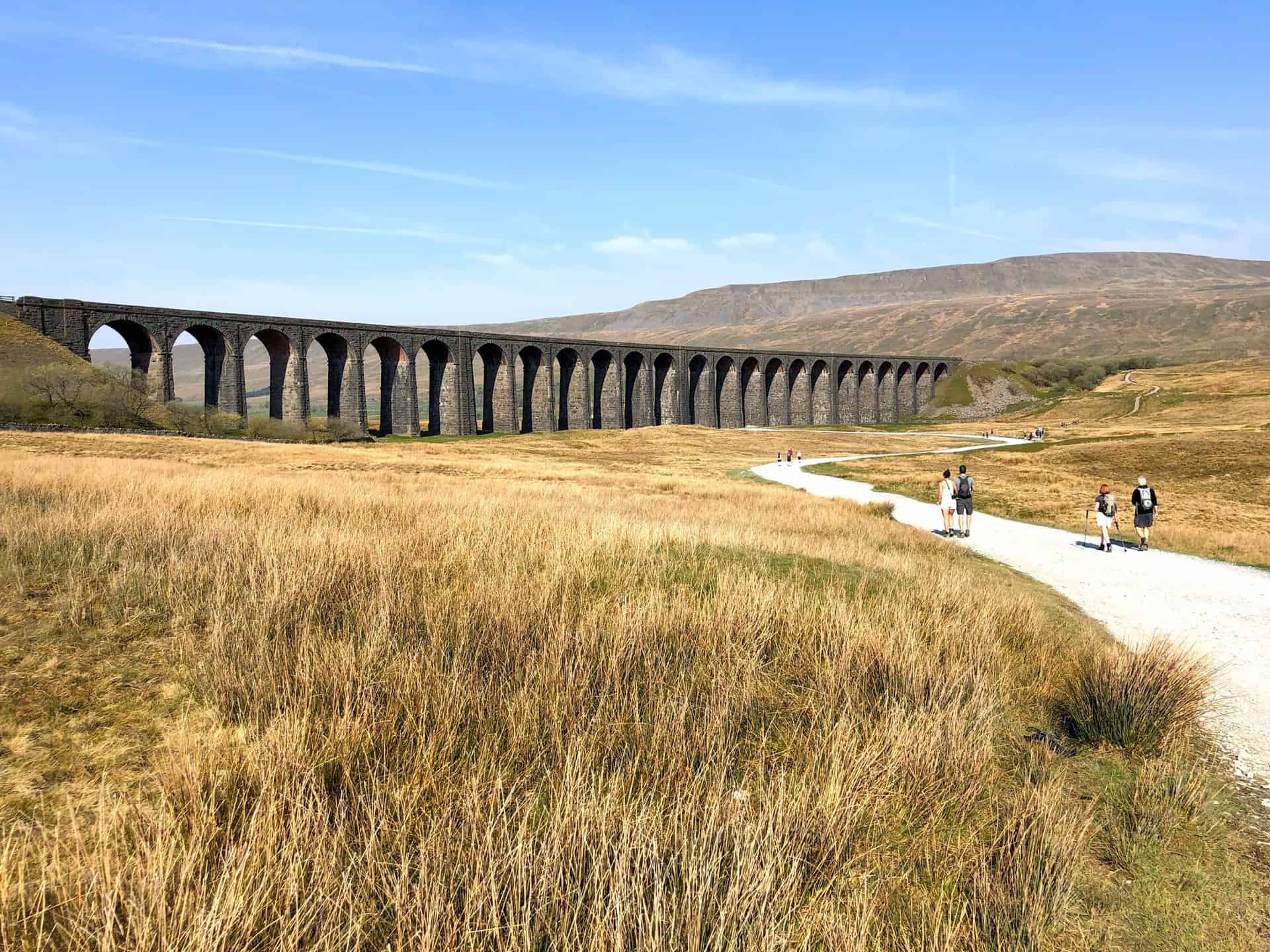
Listing and Protection
The Ribblehead Viaduct’s rich history and architectural significance have led to its recognition and protection through heritage listings.
Grade 2 Listing of Ribblehead Viaduct
The Ribblehead Viaduct has been granted Grade 2 listed status to preserve its architectural and historical importance. On 23 November 1988, the viaduct received this designation under the name ‘Batty Moss Railway Viaduct’.
Scheduled Monument Listing of Construction Camp Remains and Prehistoric Field System
In addition to the viaduct’s Grade 2 listing, the surrounding area, which contains the remains of the construction camps and a prehistoric field system, was listed as a scheduled monument on 10 May 1976. The listed entry name is ‘Ribblehead Railway Construction Camp And Prehistoric Field System’.
The monument lies in two separate areas and includes the extensive earthwork remains of the railway construction camp, as well as some fragmentary remains of a prehistoric field system.
The scheduled monument listing for the construction camp remains helps to preserve and protect the archaeological evidence of the temporary settlements that housed the workers and their families during the construction of the Ribblehead Viaduct. These settlements, known as Batty Wife Hole, Sebastopol, and Belgravia, provide a unique insight into the lives of the 19th-century workforce who laboured on this monumental project.
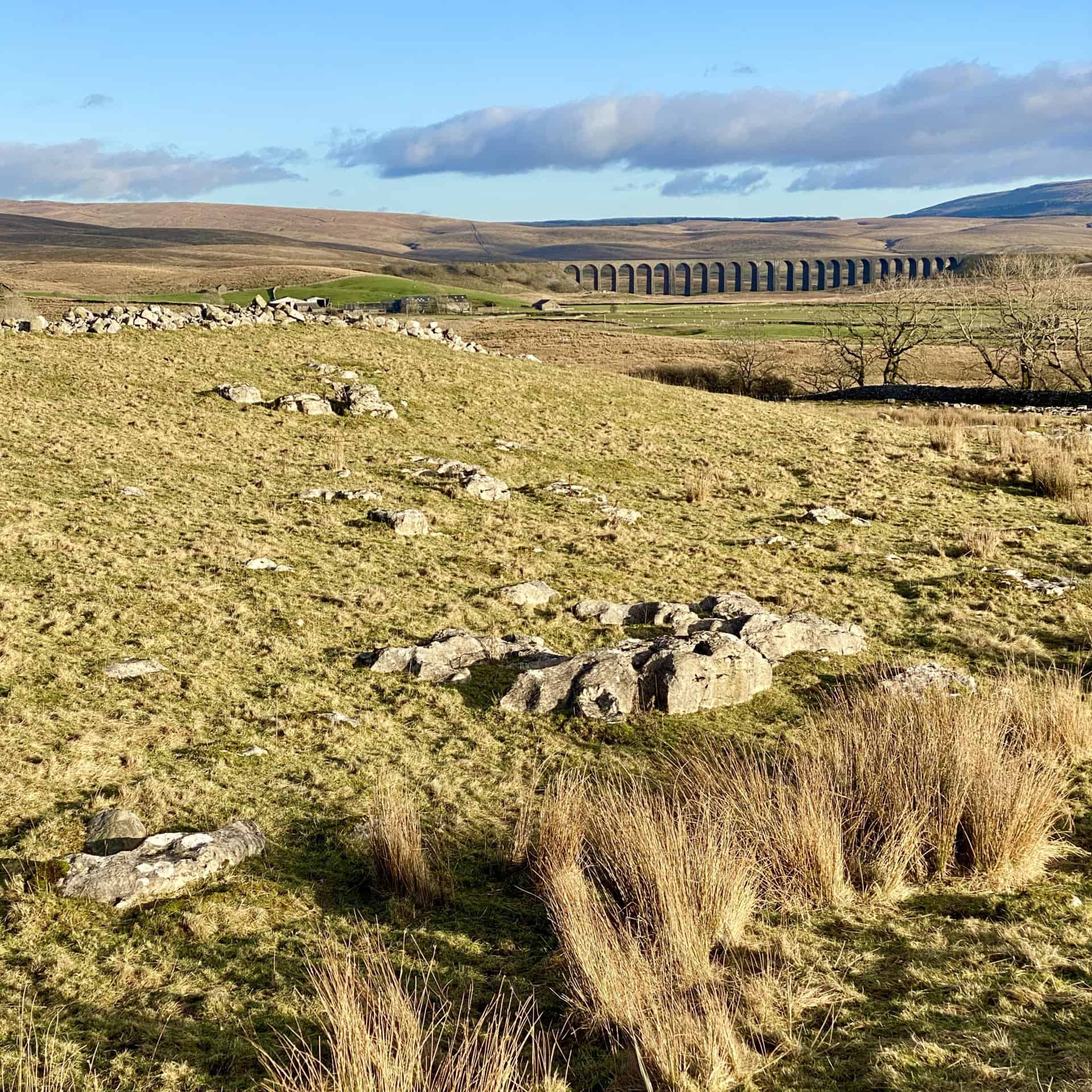
Restoration and Modern Usage
The Ribblehead Viaduct has seen its fair share of challenges throughout its existence. Despite these obstacles, dedicated efforts have been made to ensure its restoration and continued usage.
Major Restoration in the 1990s and 2000s
The Ribblehead Viaduct underwent significant restoration between 1990 and 1992, addressing structural concerns and ensuring its longevity. Additional improvements were implemented between September 1999 and March 2001, involving track renewal, ballast replacement, and the installation of new drainage systems. In November 2020, another major restoration project commenced, costing £2.1 million. This project focused on re-pointing mortar joints and replacing broken stones, with Network Rail releasing a time-lapse video of the works in June 2021.
Current Passenger and Freight Traffic
The Settle to Carlisle line is an essential part of the UK rail network, with the Ribblehead Viaduct being one of its most prominent features. As of 2016, the line carried seven passenger trains from Leeds to Carlisle per day in each direction, as well as long-distance excursions, many of which were hauled by preserved steam locomotives. Regular heavy freight trains also use the route to avoid congestion on the West Coast Main Line. Timber trains and stone from Ingleton quarry pass over the viaduct, while limestone aggregate trains from Arcow quarry sidings near Horton in Ribblesdale run to various stone terminals in the Leeds and Manchester areas on different days.
Importance to the UK Rail Network
The Settle to Carlisle railway line is one of three north to south main lines in the UK, alongside the West Coast Main Line through Penrith and the East Coast Main Line via Newcastle. The Ribblehead Viaduct’s strategic location and capacity to handle both passenger and freight traffic make it a vital component of the UK rail network.
Ribblehead Railway Station is less than half a mile to the south of the viaduct. To the north is Bleamoor Tunnel, the longest on the Settle to Carlisle line, near the foot of Whernside.
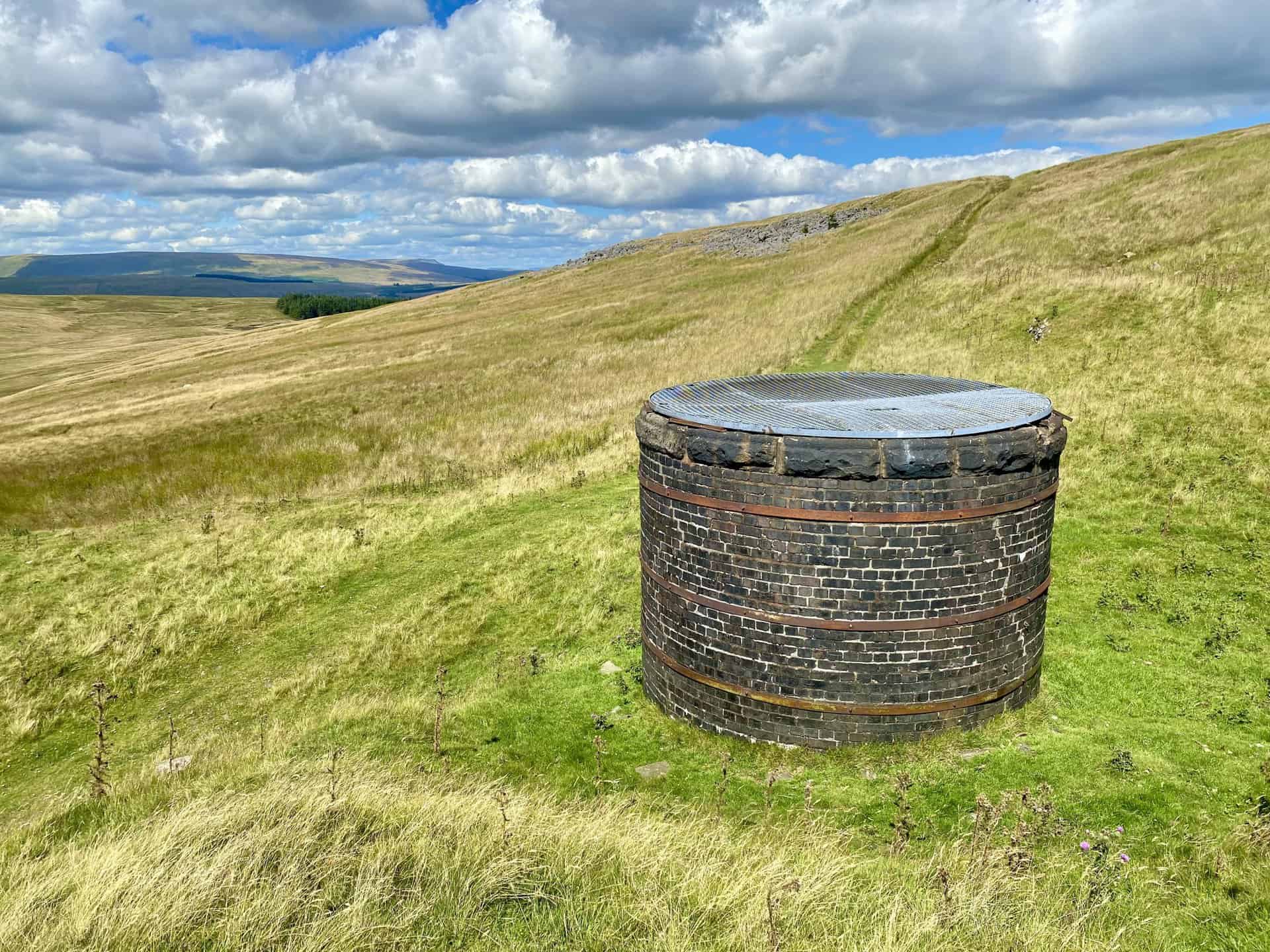
Recent Developments and Media Appearances
The Ribblehead Viaduct’s historical significance and awe-inspiring presence have not only led to extensive restoration efforts but also to increased media attention.
Network Rail’s Time-Lapse Video
To document the 2020 major restoration project Network Rail created a captivating time-lapse video showcasing the various stages of the project. This video allows viewers to witness the transformation of the viaduct and gain an appreciation for the level of skill and dedication required to complete such a complex task.
Appearances in Films and Television Series
The Ribblehead Viaduct’s dramatic landscape and stunning architecture have made it a popular location for film and television productions. Some notable examples include the British television series ‘Jericho’, which is set during the construction of a fictional viaduct in the Yorkshire Dales, and the 2012 film ‘Sightseers’, which features the viaduct as a prominent backdrop.
A silver plaque is attached to one side of the stone statue near the foot of the viaduct. The engraving depicts a 19th-century navvy shaking hands with a 20th-century engineer.

The Future of Ribblehead Viaduct
The Ribblehead Viaduct’s enduring presence, along with the ongoing efforts to preserve and maintain it, ensures that this remarkable structure will continue to captivate and inspire future generations.
Legacy of the Ribblehead Viaduct
The 24-arch structure spans across the scenic Yorkshire Dales, providing both a functional transport link and a stunning visual spectacle. The story of its construction and the immense challenges faced by the workers during the Victorian era continue to resonate, providing valuable insight into the industrial past and the incredible determination of the human spirit.
Its Continued Significance and Preservation
The Ribblehead Viaduct has not only survived the passage of time but has also managed to maintain its relevance in the modern era. The efforts of organisations like the FoSCL and Network Rail have ensured that the viaduct remains structurally sound and functional.
As a Grade 2 listed structure and a scheduled monument, the Ribblehead Viaduct receives the protection it deserves. Ribblehead Viaduct is not just an extraordinary feat of engineering but also a cherished piece of history, a symbol of resilience and human achievement that will endure well into the future.
Key Features of the Ribblehead Viaduct
| Name | Ribblehead Viaduct or Batty Moss Viaduct |
| Grid reference | Ordnance Survey SD 75944 79471 |
| Built by | Midland Railway |
| Workforce | Up to 2300 men |
| Date started | July 1870 on the foundations |
| Date finished | The end of 1874 |
| Length | 404.8 metres |
| Height | 32 metres at its highest point |
| Height above sea level | 300 metres |
| Number of arches | 24 |
| Span of arches | 13.7 metres |
| Depth of foundations | 7.6 metres |
| Number of bricks used | 1.5 million |
Amazon’s Top Walking Boots: Four Standout Choices for Men and Women
For walking and hiking, the right boots are essential for both comfort and safety. While Amazon boasts a wide range, certain boots emerge as top-sellers. From those, here are four I personally favour. As an Amazon affiliate, I may earn a small commission from any purchases made through the links provided. This helps support the upkeep of this website. Rest assured, you won’t pay a penny extra, but your purchase will contribute to keeping my site running smoothly. Happy walking!

Berghaus Men’s Hillmaster II Gore-Tex Walking Boots
These fully waterproof leather walking boots feature a Gore-Tex lining, ensuring no water enters whilst allowing feet to breathe and stay cool. Made from full-grain leather, they promise unmatched durability and comfort. The boots come with memory foam tongues and cuffs that mould to your feet for a tailored fit, and the Vibram Hillmaster outsoles offer confidence on challenging terrains.

Salewa Men’s Mountain Trainer Mid Gore-Tex Walking Boots
Made from durable suede and abrasion-resistant textile, these men’s hiking boots are both lightweight and sturdy. The upper material is enhanced by a 360° full rubber sheath. Their dual-layer midsole with Bilight technology ensures ergonomic cushioning and grip, especially on extended hikes. The Vibram Wrapping Thread Combi outsoles allow a natural walking feel, and the Gore-Tex lining provides waterproofing, breathability, and optimal weather protection. Furthermore, the patented Salewa 3F system ensures flexibility, a secure heel grip, and a blister-free fit.

Berghaus Women’s Supalite II Gore-Tex Walking Boots
Specially designed for women, these hiking boots offer waterproofing and breathability, thanks to their Gore-Tex lining. Crafted from full-grain abrasion-resistant leather, they’re durable enough for the toughest hikes. The Supalite soles ensure stability and traction, and the EVA midsoles add comfort for extended walks.

Merrell Women’s Moab 3 Mid Gore-Tex Walking Boots
These hiking boots incorporate a Gore-Tex waterproof membrane, blending breathability with superior waterproof performance. The combination of pigskin leather and mesh on the uppers, along with the suede outer material, ensure durability and style. Enhancements include 100% recycled laces, webbing, and mesh lining. Additionally, bellows tongues, protective toe caps, and Vibram TC5+ rubber soles ensure protection and ease on any terrain.